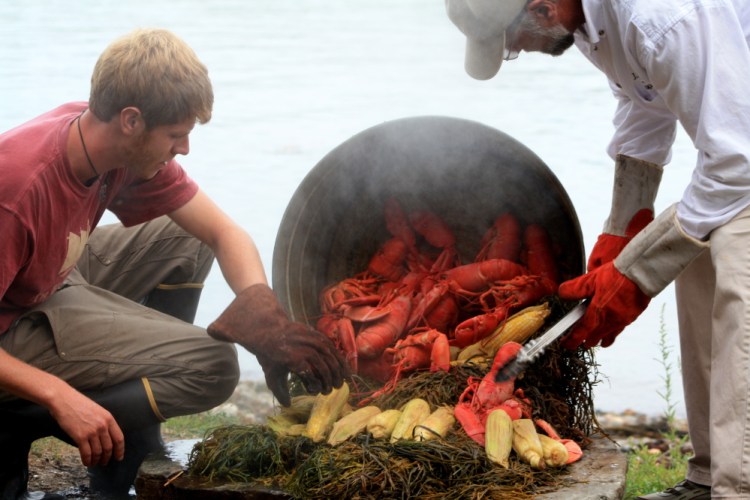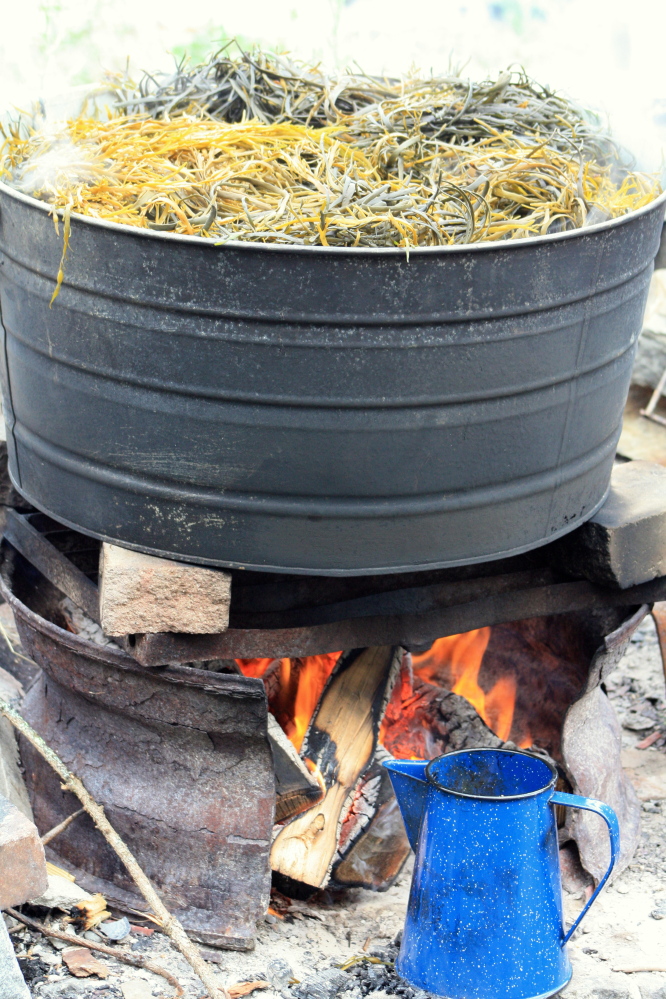What’s the best meal you’ve ever had? Maybe it was dinner at a 4-star restaurant in Manhattan. Or a meal you shared with someone you loved at a tapas bar in Madrid while on an awesome vacation.
For me and our guests on the Schooner J. & E. Riggin, owned and captained by my husband and me in Penobscot Bay all summer, our traditional Maine lobster bake just might be the best meal (luckily for us, meals) we’ve ever eaten. A lobster bake is an occasion everyone who loves food should experience at least once.
To eat Maine’s iconic meal in a restaurant is a treat. But the word “treat” can’t capture what it’s like to enjoy lobster prepared on an open campfire, eaten on the shore of an uninhabited island, the sound of waves lapping at the sand. It’s one of those full-throttle, all-out moments in life when you’ll want to be hyper-aware of every detail so you can soak it up and never forget it.
My husband and I always plan such a lobster bake for our guests. We anchor near an undisturbed island in the late afternoon, then travel ashore, six at a time, on our yawl boat (a sturdy little boat we use as both a launch and a tug boat). We hop across granite rocks to the beach, and everyone wanders off – combing the shore, exploring inland, the brave ones swimming. Some even help the crew set up for dinner.
A fire is lit, corn is shucked and an assortment of goodies is put out to tide us over until the lobster is ready. Once the fire is enthusiastically consuming the firewood we bring with us, we fill the lobster pot, a huge galvanized tub, with 2 to 3 inches of salt water and set it over the fire. While we wait for the water to boil, the crew and any guests willing to wade into the cold Maine water gather armloads of seaweed, being careful to leave some at each spot so that more can grow back in its place.
We layer the lobsters in the pot, as well as corn, mussels and clams. We cover everything with a “lid” of seaweed, and we wait, rotating the pot occasionally for even cooking. Once the water returns to a boil, we pull some of the seaweed aside to check the lobsters’ color. When they’re red all over, we take the pot off the fire and make a bed of seaweed on a flat rock on which to set out our feast.
Lobster bakes go way back. It’s thought that Native Americans taught the colonists the technique. Centuries ago, lobster bakes were done in a hole dug in the ground and lined with rocks. Easy enough in southern New England, with its sandy beaches. But on our granite-strewn islands, well, good luck with that.
In Maine, people traditionally made a fire on the granite within a ring of rocks. But that’s no longer a good idea. The world is an ever more crowded place, even on remote Maine islands and beaches, so it’s best to leave no imprint on natural places. Laying a fire within a ring of rocks causes that centuries-old granite to crack into brittle chips, plus it leaves scorch marks. We build our fires on a fire pan, which protects the site, the beach and the rocks. Even a metal trash can lid will do in a pinch.
At our island lobster bakes, we operate under the Girl Scout rule – leave no trace. Whatever we take onto the island, we take off, too. Often we pick up litter while exploring the island and carry that away with us – our way to leave the spot cleaner than we found it. Five minutes after we’ve sailed away, we hope no one can tell we were ever there.
An uninhabited island beach is an idyllic backdrop for a lobster bake. But it’s not absolutely necessary. Your own backyard could do nicely. Or a local beach (where you have permission to be and to build a fire).
I guarantee that you and your guests will cherish this meal, and the memories of it. Plus whenever you buy lobster, you are supporting local families and the businesses that help our beautiful state thrive.
LOBSTER BAKE IN YOUR OWN BACKYARD
Serves 8
EQUIPMENT: You’ll need to either make a roaring campfire or use a propane cooker on a tripod stand. You could also set the pot on an outdoor grill, but be sure it can get hot enough with the lid of the grill open or removed. Other equipment you need: a large pot with a steamer basket and lid. To serve 8 people, 12 lobsters and a 36-quart pot will do. Garlic may not be traditional, but it’s tasty. On the beach, we dispense with the slippery metal crackers and picks and instead use a palm-sized rock to rap on the shells and reach the meat. We use the skinniest claw as a pick.
12 (11/2) pound live Maine lobsters
2 pounds clams
2 pounds mussels
8 ears of corn
8 small whole onions, peeled
2 whole heads garlic
1/2 cup salted butter, melted
Juice of 1/2 lemon
Bring 2 to 3 inches of salted water to a rolling boil in the lobster pot with the steamer basket inserted. Add the lobsters, clams, mussels, corn, onions and garlic in that order and cover the pot for 20 to 25 minutes.
While the lobsters are cooking, melt the butter with the lemon juice and keep warm.
The lobsters are done when they are red all over and the antennae pull off easily. Remove the steamer basket and arrange your feast on several platters. Serve hot with the melted butter.
S’MORES
Once everyone has had their fill of lobster, we slice watermelon and lay out the makings for s’mores. A lively discussion over how to make the best s’more always ensues, also the proper way to roast a marshmallow.
Serves 1
1/2 Hershey bar
1 graham cracker, broken in half
2 marshmallows
Place the Hershey bar on a graham cracker half and move it near the fire so the chocolate can warm.
Place the marshmallows on a metal roasting skewer (not driftwood) and slowly turn it over the hot coals until the marshmallows turn golden brown. Take your time – the impatient folks end up with burnt marshmallows. Some poor souls actually like them this way – go figure.
Place the marshmallows, still on their skewer, on the chocolate-covered graham cracker. Using the second half of the graham cracker as a lid of sorts, hold the marshmallows in place and pull the skewer away.
Eat! If you don’t end up with some on your face, then you haven’t done it right and should make yourself another one.
Anne Mahle of Rockland is co-captain of the Schooner J. & E. Riggin and the author of “Sugar and Salt: A Year at Home and at Sea.” She blogs at athomeatsea.com and can be reached at:
chefannie@ mainewindjammer.com
Send questions/comments to the editors.




Success. Please wait for the page to reload. If the page does not reload within 5 seconds, please refresh the page.
Enter your email and password to access comments.
Hi, to comment on stories you must . This profile is in addition to your subscription and website login.
Already have a commenting profile? .
Invalid username/password.
Please check your email to confirm and complete your registration.
Only subscribers are eligible to post comments. Please subscribe or login first for digital access. Here’s why.
Use the form below to reset your password. When you've submitted your account email, we will send an email with a reset code.